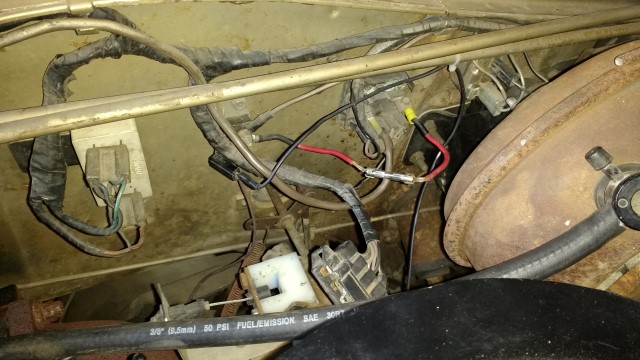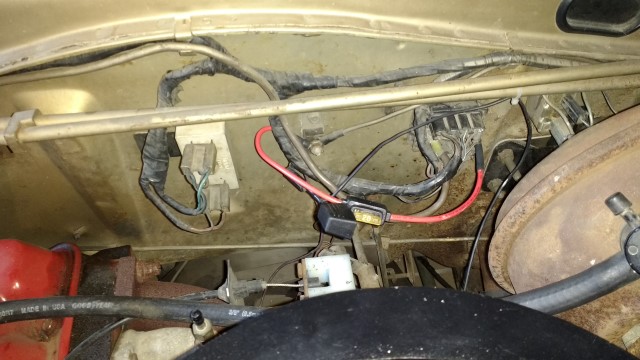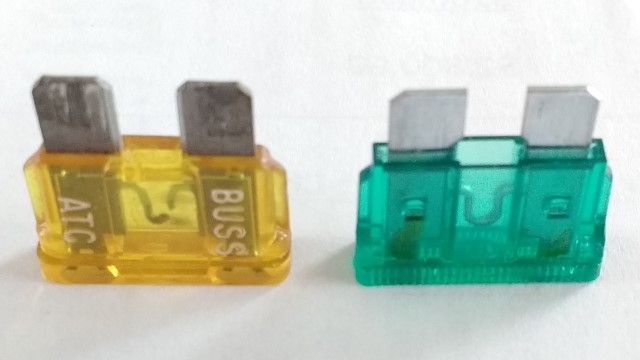My first experience with fusible links happened while I driving home in my 1965 Barracuda on the QEW back in the late 1990s. I was driving along one evening at the speed limit with my headlights on and everything suddenly went dead. I coasted to the shoulder and, luckily, there was a house within a 10 minute walk where I was able to call CAA. [Be sure to periodically check your flashlight: I discovered how dark it can be after my lantern's flashing yellow lamp died when its 6V battery gave out within only a few minutes.]
After eventually getting towed home, I decided that I would not be in that position again. The fusible link that failed (my only fusible link) was 16 gauge wire between my 12 gauge wire from the battery and the bulkhead connector, which powers the fuse panel. The highest current flow is typically for battery charging and the following alternators were available in 1965 for Plymouths:
- 26 ± 3 amps (Standard AV1, With 170 or 225 CID engines)
- 34.5 ± 3 amps (Standard All Others)
- 39 ± 3 amps (Heavy Duty and/or Air Conditioning)
The charging circuit in the wiring harness should therefore be sized for 39 amps. The original fusible in my car looks similar to this replacement part.

To protect my 12 AWG wire from the battery, I need to ensure that its maximum current flow does not become excessive. A measure of a wire's maximum current limit is "ampacity", which is the amount of current a conductor can handle before its temperature exceeds accepted limits. Many online sources (such as UIUC Physics 436 EM Fields & Sources II Lecture Notes) show the following ampacities for chassis wiring (based on the Handbook of Electronic Tables and Formulas for American Wire Gauge), which is a short length in free air and not bundled with others.
| AWG gauge | Conductor Diameter Inches |
Conductor Diameter mm |
Ohms per 1000 ft. | Ohms per 1000 m | Maximum Amps for Chassis Wiring |
| 2 | 0.2576 | 6.54304 | 0.1563 | 0.512664 | 181 |
| 3 | 0.2294 | 5.82676 | 0.197 | 0.64616 | 158 |
| 4 | 0.2043 | 5.18922 | 0.2485 | 0.81508 | 135 |
| 5 | 0.1819 | 4.62026 | 0.3133 | 1.027624 | 118 |
| 6 | 0.162 | 4.1148 | 0.3951 | 1.295928 | 101 |
| 7 | 0.1443 | 3.66522 | 0.4982 | 1.634096 | 89 |
| 8 | 0.1285 | 3.2639 | 0.6282 | 2.060496 | 73 |
| 9 | 0.1144 | 2.90576 | 0.7921 | 2.598088 | 64 |
| 10 | 0.1019 | 2.58826 | 0.9989 | 3.276392 | 55 |
| 11 | 0.0907 | 2.30378 | 1.26 | 4.1328 | 47 |
| 12 | 0.0808 | 2.05232 | 1.588 | 5.20864 | 41 |
| 13 | 0.072 | 1.8288 | 2.003 | 6.56984 | 35 |
| 14 | 0.0641 | 1.62814 | 2.525 | 8.282 | 32 |
| 15 | 0.0571 | 1.45034 | 3.184 | 10.44352 | 28 |
| 16 | 0.0508 | 1.29032 | 4.016 | 13.17248 | 22 |
| 17 | 0.0453 | 1.15062 | 5.064 | 16.60992 | 19 |
| 18 | 0.0403 | 1.02362 | 6.385 | 20.9428 | 16 |
| 19 | 0.0359 | 0.91186 | 8.051 | 26.40728 | 14 |
| 20 | 0.032 | 0.8128 | 10.15 | 33.292 | 11 |
| 21 | 0.0285 | 0.7239 | 12.8 | 41.984 | 9 |
| 22 | 0.0253 | 0.64516 | 16.14 | 52.9392 | 7 |
| 23 | 0.0226 | 0.57404 | 20.36 | 66.7808 | 4.7 |
| 24 | 0.0201 | 0.51054 | 25.67 | 84.1976 | 3.5 |
| 25 | 0.0179 | 0.45466 | 32.37 | 106.1736 | 2.7 |
| 26 | 0.0159 | 0.40386 | 40.81 | 133.8568 | 2.2 |
| 27 | 0.0142 | 0.36068 | 51.47 | 168.8216 | 1.7 |
| 28 | 0.0126 | 0.32004 | 64.9 | 212.872 | 1.4 |
| 29 | 0.0113 | 0.28702 | 81.83 | 268.4024 | 1.2 |
| 30 | 0.01 | 0.254 | 103.2 | 338.496 | 0.86 |
| 31 | 0.0089 | 0.22606 | 130.1 | 426.728 | 0.7 |
| 32 | 0.008 | 0.2032 | 164.1 | 538.248 | 0.53 |
Since the maximum current for 12 AWG is 41 amps, I thought I would safe to replace my fusible link (battery to bulkhead connector) with a 30 amp AGC glass tube fuse. This would allow me to quickly get back on the road (if I remember to bring spare fuses) and avoid calling for a tow. This served me well for many years and many miles until 2017. This fuse holder normally has a plastic cover but in the photo below, the fuse cover is missing.

With the mild winter we've had in 2017, I took my car over to Buffalo at the end of February to get gas and groceries. While in the Wegman's parking lot, upon turning off the engine and turning my key to the accessory position to listen to the radio after my wife closed her door, everything went dead. I've had similar issues in the past with the bad battery terminal connection so I checked my connections and all were tight. I then spun the glass battery fuse in its connectors and the lights came back on. After starting the car, I got as far as the stop sign in the parking lot where it happened again. This time, I loosened and re-tightened my battery terminals and the lights came back on again. After driving back along the Thruway, I got as far as the Duty Free Americas by US Customs at the Peace Bridge before the car once again died. Nothing I did previously worked this time so I admitted defeat and called CAA for a tow. While waiting, I discovered that my seemingly good 30 amp glass fuse was defective (bad solder between the fuse and end cap?) since I could get the lights to come back on if I touched the fuse's connectors together. Unfortunately, my spare 30 amp fuses were not with me and I did not have any way to bypass the fuse for the trip home.
Because my old AGC fuse holder had frayed wires and because blade fuses are more common now, I decided to replace this AGC fuse with a regular ATC/ATO blade-style fuse. 'ATC' fuse elements are completely closed to atmosphere inside of their plastic housings. 'ATO' fuse elements are open to atmosphere and can potentially fail from corrosion. ATC fuses would likely present less risk of sparks and shocks. I have not found a definitive guide for ATO vs ATC usage and the ATC/ATO description is used interchangeably (and misleadingly IMHO). Presumably, ATO fuses are cheaper than ATC fuses because ATO fuses seem to be more prevalent than ATC fuses. Also, ATO fuses appear to be the standard product offering from Littelfuse while ATC appears to be a Bussman standard product.

I tried a 20 amp ATC fuse (salvaged from a wreck during an earlier quest for parts) but, after a long cold-weather cranking session, it blew shortly after my car started while I was warming up the engine. I replaced it with a 30 amp ATO fuse and I've had no fuse issues so far. The photo below shows the difference between a blown 20A ATC fuse (left) with a new 30A ATO fuse (right).

Fuses are used to protect electrical circuits from overheating and causing fires. Every conductor has resistance and the heat it generates (ie, power it absorbs) can be calculated by P = I2 * R. If more heat is generated than can be dissipated into the air, the conductor can overheat and melt. Conservatively sized wires do not overheat from normal electrical loads. Fusible links were used in automotive applications so the manufacturer could get away with using lower-cost, thinner wires. Fuses blow quickly when the current passing through it reaches its rating. Fusible links take longer to overheat and can withstand temporary excess current for longer periods than fuses. See Fusing of Wires by Electrical Current.
Fusible links are governed by SAE Standard J156 and appear to use the same stranded copper wire as SXL (special purpose cross-linked) with XLPE (chemically cross-linked polyethylene) insulation automotive primary wire used in engine compartments where higher heat resistance is required according to SAE J1128. Fusible link wire has fusible link markings and Hypalon insulation, which is better for containing molten copper than XLPE insulation.
The standard practice for fusible links is sizing it 2 AWG even sizes (4 numerical sizes) smaller than the wire they are protecting. For example, a 16 AWG fusible link is used inline with a 12 AWG wire. Replacement fusible links should be about the same length as the original and are generally about 5-6" long. Using too long of a fusible link will cause an excessive voltage drop because of its smaller size.
Mopar Fusible Links (from Service Manuals)
| Size - AWG |
Color Code | Color |
| 10 | DGN | Dark Green |
| 12 | BK | Black |
| 14 | RD | Red |
| 16 | DB | Dark Blue |
| 18 | GY | Gray |
| 20 | OR | Orange |
| 22 | WT | White |
Delphi Fusible Links (White Products Fusible Links Specifications)
| Size | Color | Markings |
| 22-ga. - 0.35 mm | Orange (Rust) | 0.35 SQMM FUSIBLE LINK |
| 20-ga. - 0.5 mm | Gray | 0.5 SQMM FUSIBLE LINK |
| 18-ga. - 0.8 mm | Blue | 0.8 SQMM FUSIBLE LINK |
| 16-ga. - 1.0 mm | Black | 1.0 SQMM FUSIBLE LINK |
| 14-ga. - 2.0 mm | Gray | 2.0 SQMM FUSIBLE LINK |
| 12-ga. - 3.0 mm | Blue | 3.0 SQMM FUSIBLE LINK |
| 10-ga. - 5.0 mm | Orange (Rust) | 5.0 SQMM FUSIBLE LINK |
| 8-ga. -8.0 mm | Black | 8.0 SQMM FUSIBLE LINK |
The Mystery of Fusible Links... Unravelled
Automotive Electrical Handbook - Fusible Links
Modern Diesel Technology: Electricity and Electronics - Fusible Links
